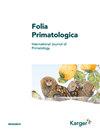Nocturnal Primate Communication: Ecology, Evolution and Conservation
IF 1.2
4区 生物学
Q2 ZOOLOGY
引用次数: 3
Abstract
Auditory, visual and olfactory cues play varying roles in non-human primate communication, and these systems have been intensively studied over the last several decades. The use of vocalisations as a primary mode of communication has been the focus of much research, especially in attempts to understand the origins of human language, with a major focus on anthropoid primates and diurnal lemurs. Over the last decade, technological advances have allowed researchers to begin to conduct in-depth investigations into the communication systems exhibited by the nocturnal and cathemeral prosimian primates, including tarsiers, lemurs and lorises. Understanding how nocturnal prosimians use visual, olfactory and auditory cues is vital for reconstructing the origins of primate communication systems. In this special issue, we highlight some of the more exciting advances in the communication strategies of the prosimians. Contributions come from work conducted in Kenya, Tanzania, Senegal, Rwanda, Madagascar and the Indonesian islands of Java and Sulawesi. Topics will include: the description of novel ultrasonic vocalisations, including frequency and function of these newly discovered calls; the possible use of vocalisations to navigate and assemble at sleep sites; the importance of species-specific contact vocalisations for the identification of new species; the use of urinary and glandular signals to communicate and the methods developed to understand this complex communication in the field; the use of vocalisations for niche separation among nocturnal primates from mainland Africa and Madagascar; and whether or not we can use new technologies to discern whether prosimians use vocalisations for individual identification of group members. We discuss the importance of new field methods including novel equipment and techniques, the use of vocalisation to influence conservation practices and the importance of comparing across prosimian taxa to reconstruct the communication systems of our early primate ancestors.夜间灵长类动物的交流:生态学、进化和保护
听觉、视觉和嗅觉线索在非人类灵长类动物的交流中发挥着不同的作用,在过去的几十年里,这些系统得到了深入的研究。将发声作为主要的交流方式一直是许多研究的焦点,尤其是在试图了解人类语言起源的过程中,主要关注的是类人猿灵长类动物和日间狐猴。在过去的十年里,技术进步使研究人员能够开始对夜间和猫猫类原灵长类动物表现出的通信系统进行深入调查,包括跗类、狐猴和懒猴。了解夜行原猴如何利用视觉、嗅觉和听觉线索,对于重建灵长类动物交流系统的起源至关重要。在本期特刊中,我们将重点介绍普罗希米亚人在沟通策略方面取得的一些更令人兴奋的进展。捐款来自在肯尼亚、坦桑尼亚、塞内加尔、卢旺达、马达加斯加以及印度尼西亚爪哇岛和苏拉威西岛进行的工作。主题包括:描述新的超声波发声,包括这些新发现的叫声的频率和功能;可能使用发声来导航和在睡眠地点集合;物种特异性接触发声对识别新物种的重要性;使用尿液和腺体信号进行交流,以及在现场了解这种复杂交流的方法;非洲大陆和马达加斯加夜间灵长类动物利用发声进行生态位分离;以及我们是否可以使用新技术来辨别原拟人是否使用发声来识别群体成员。我们讨论了新的野外方法的重要性,包括新的设备和技术,使用发声来影响保护实践,以及在原灵长类分类群之间进行比较以重建我们早期灵长类祖先的交流系统的重要性。
本文章由计算机程序翻译,如有差异,请以英文原文为准。
求助全文
约1分钟内获得全文
求助全文
来源期刊

Folia Primatologica
生物-动物学
CiteScore
3.30
自引率
10.50%
发文量
36
审稿时长
>12 weeks
期刊介绍:
Recognizing that research in human biology must be founded on a comparative knowledge of our closest relatives, this journal is the natural scientist''s ideal means of access to the best of current primate research. ''Folia Primatologica'' covers fields as diverse as molecular biology and social behaviour, and features articles on ecology, conservation, palaeontology, systematics and functional anatomy. In-depth articles and invited reviews are contributed by the world’s leading primatologists. In addition, special issues provide rapid peer-reviewed publication of conference proceedings. ''Folia Primatologica'' is one of the top-rated primatology publications and is acknowledged worldwide as a high-impact core journal for primatologists, zoologists and anthropologists.
 求助内容:
求助内容: 应助结果提醒方式:
应助结果提醒方式:


